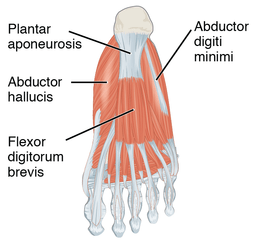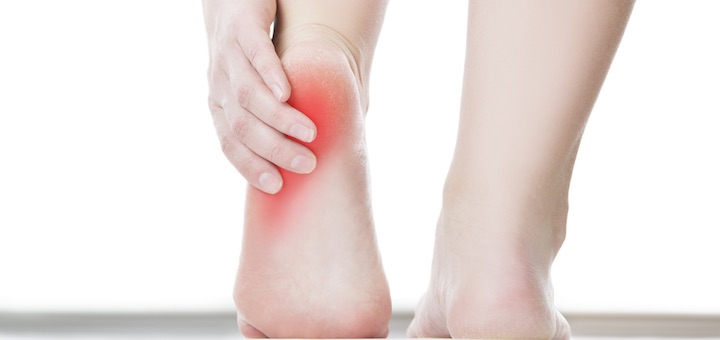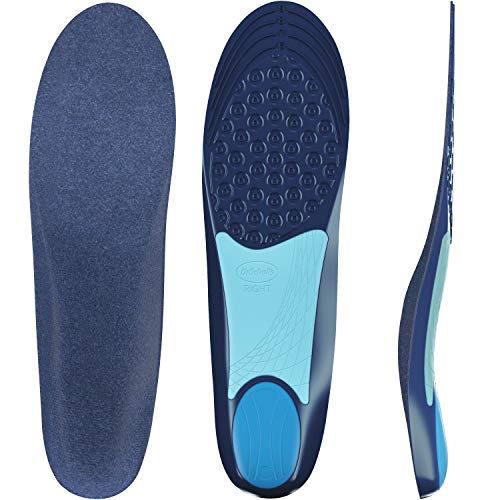
Plantar fasciitis (pronounced ‘fashee-EYE-tiss’), often referred to as Runner’s Heel, is a prevalent overuse injury among runners, regardless of experience level or distance.
Affecting roughly 10% of runners at some point in their running journey, it results from inflammation or microtears in the plantar fascia—a thick band of tissue that supports the arch of your foot.
Understanding the causes and management strategies can help keep you running while minimizing discomfort and recovery time.
1. What Is Plantar Fasciitis?
Plantar fasciitis occurs when the plantar fascia—a thick, fibrous tissue that stretches from the heel to the toes—becomes inflamed.
This tissue supports the foot’s arch and helps absorb impact during walking or running. When it’s strained or overused, inflammation and microtears can lead to sharp heel pain.
Plantar fasciitis is a leading cause of heel discomfort, and if left untreated, it can become chronic, making activities like running, walking, and even daily tasks painful and difficult.
Disclaimer: This post is not medical advice and is not intended to provide diagnosis or treatment for any medical conditions. Please consult a physician or other health care professional for your specific health care and/or medical needs or concerns.
2. What Causes Plantar Fasciitis?
Plantar fasciitis is mainly caused by excessive stress on the heel, particularly during activities like running, walking, and dancing. Overtraining or rapidly increasing exercise intensity can strain the plantar fascia, leading to small tears and inflammation.
Additional factors such as exercising on hard surfaces, tight calf muscles, inadequate footwear support, and carrying extra body weight contribute to the risk.
Although the exact cause isn’t always clear, these conditions are common triggers, especially for people aged 40-60.
Key Risk Factors:
- Running or walking on hard surfaces
- Tight calf or heel muscles
- Wearing unsupportive shoes
- Carrying extra body weight
- Standing for prolonged periods

As shown in the picture above, the Plantar fascia, also known as the plantar aponeurosis, is a strong, thick band of connective tissue that runs across the sole of the foot.
3. Symptoms and Diagnosis of Plantar Fasciitis
➤ Symptoms:
The primary symptom of plantar fasciitis is intense heel pain, especially after waking up or sitting for extended periods. Pain often worsens with activity, particularly after standing or walking for prolonged durations.
Other common symptoms include:
- Sharp heel pain in the morning or after resting
- Increased heel pain after standing or walking for a long time
- Pain in the arch of the foot
- Aggravated pain when climbing stairs or standing on toes
- Swelling or tenderness in the heel or arch
- Pain spreading from the heel to the sole
- Difficulty walking or limping due to discomfort

Plantar Fasciitis Common Symptom:
Sharp and Stabbing Heel Pain
➤ Diagnosis:
A doctor will assess your symptoms and perform a physical examination, pressing on the bottom of the foot to pinpoint tenderness and asking you to walk or stand on your toes.
Imaging tests like X-rays, ultrasounds, or MRIs may be used to detect damage, inflammation, or thickening of the plantar fascia. These tests also help rule out other conditions, such as fractures, that could cause similar heel pain.
4. Treatment Options for Plantar Fasciitis
There are several effective ways to manage plantar fasciitis, ranging from home care techniques to medical interventions. The goal is to reduce inflammation, relieve pain, and promote healing in the affected area.
- Stretching Exercises: Regularly stretching the calf and foot muscles can ease strain and improve flexibility.
- Ice and Heat Therapy: Ice reduces inflammation, while heat relaxes tight muscles and improves blood flow.
- Orthotic Devices: Custom orthotics or shoe inserts provide arch support and reduce pressure on the plantar fascia.
- Arch Taping: Taping supports the foot’s structure, relieving pain and promoting proper alignment.
- Anti-Inflammatory Medications: Non-steroidal anti-inflammatory drugs (NSAIDs), like ibuprofen, help alleviate pain and reduce inflammation.
- Physical Therapy: A physical therapist can tailor exercises to strengthen the foot and calf, reduce pain, and improve mobility.
- Night Splints: Wearing night splints stretches the fascia during sleep, reducing morning pain.
- Cortisone Injections: For severe cases, cortisone injections can be used to quickly reduce inflammation and provide longer-term relief.
Managing plantar fasciitis often requires a combination of treatments. Stretching, orthotic support, and ice therapy are generally effective in most cases. If symptoms persist, it’s important to consult a healthcare professional for further evaluation and more advanced interventions.
5. Exercises for Preventing and Treating Plantar Fasciitis
Incorporating targeted exercises into your routine can help alleviate pain from plantar fasciitis and prevent future issues by improving flexibility, strength, and overall foot health.
Calf Stretch
How to do it: Stand facing a wall with your hands placed against it. Step your right foot back around two feet, keeping your heel flat on the ground. Slowly lean forward until you feel a stretch in your calf muscle. Hold the position for 20–30 seconds, then switch legs.
Benefits: This stretch targets tight calf muscles, which are often linked to plantar fasciitis by placing excess strain on the plantar fascia.

Plantar Fascia Stretch
How to do it: Sit on the floor with your legs extended. Use a towel or resistance band, looping it around the ball of your foot. Gently pull the towel toward you until you feel a stretch in the arch of your foot. Hold for 20–30 seconds, then repeat on the other foot.
Benefits: This stretch loosens the plantar fascia and reduces tension, helping alleviate pain and improve flexibility.
Heel Drops
How to do it: Stand on the edge of a step with your heels hanging off. Slowly raise your heels as high as possible, then lower them until your heels dip below the step. Perform 10–15 repetitions.
Benefits: Heel drops strengthen the calf muscles and Achilles tendon, providing better support for the plantar fascia and reducing heel pain.
Toe Curls
How to do it: Sit with a small towel placed under your feet. Use your toes to scrunch and lift the towel. Repeat this curling motion 10–15 times.
Benefits: This exercise strengthens the small muscles in your feet, helping improve arch support and stability, which reduces strain on the fascia.
Strengthening Exercises
How to do it: Incorporate exercises like toe raises, calf raises, and heel raises into your routine. For example, stand on your toes and raise your heels, then lower them. Perform 10–15 repetitions.
Benefits: Strengthening these muscles improves foot and ankle stability, preventing overuse injuries like plantar fasciitis.
Foam Rolling
Benefits: Foam rolling helps release tension and reduce inflammation in the plantar fascia, providing relief from pain and stiffness.
How to do it: Use a foam roller or tennis ball under the arch of your foot. Roll your foot back and forth for 10–15 minutes, applying gentle pressure to massage the tissue.

These exercises are a proactive approach to managing plantar fasciitis by targeting key muscles and tissues. By regularly performing them, you can ease discomfort and help prevent future flare-ups.
6. Can You Run With Plantar Fasciitis?
Yes, it’s possible to run with plantar fasciitis, but you must take specific precautions to avoid worsening the condition. Incorporating stretching, strengthening exercises, and using orthotics can help manage pain and prevent further injury. Appropriate footwear is also crucial, providing extra arch support and cushioning. It’s essential to consult with your doctor before continuing any running routine with this condition.
Key considerations:
- Avoid increasing running intensity or distance if pain persists during your run.
- Running should be stopped altogether if the pain is severe or worsens, as the high-impact nature of running can exacerbate symptoms.
📌 Important: Running with untreated plantar fasciitis can lead to more serious foot problems in the future.
If pain persists from start to finish during your run, it’s time to rest, recover, and seek professional advice.
7. How Runners Can Prevent Plantar Fasciitis
Stretch and Strengthen Your Feet and Calves
Regular stretching and strengthening exercises for your feet and calves help alleviate pressure on the plantar fascia, reducing the risk of injury.
Wear Proper Running Shoes
Choosing the right running shoes is essential for proper arch support and cushioning. The right shoes prevent strain on your plantar fascia and reduce the risk of injury.
Gradually Increase Mileage
To avoid overloading the fascia, increase your running distance slowly—no more than 10% per week. Take “down weeks” every few weeks, reducing your mileage to allow recovery.
Take Rest Days
Incorporate rest days between runs to give your feet time to recover, preventing overuse injuries like plantar fasciitis.
Ice Your Feet After Running
After each run, ice your feet for 10–15 minutes to reduce inflammation and soothe irritated tissues.
Use Arch Supports or Orthotics
Arch supports or orthotics can offer additional stability and reduce strain, especially for runners with high arches who are more prone to plantar fasciitis.
By combining these strategies, runners can significantly reduce the risk of developing plantar fasciitis while maintaining their performance.
8. Tips for Running with Plantar Fasciitis
Running with plantar fasciitis requires extra care to manage symptoms and prevent the worsening of the condition. Below are detailed tips to help you stay active while reducing discomfort:
Tip 1 – Stretch and Warm Up
Before your run, make sure to warm up properly by focusing on dynamic stretches for your calves, Achilles tendon, and plantar fascia. This can help reduce tension and pain, effectively preparing the fascia for impact.
Tip 2 – Wear Supportive Shoes
Choose running shoes with proper arch support and cushioning designed to alleviate plantar fascia strain. The right footwear helps distribute pressure evenly across the foot.
Tip 3 – Use Orthotics
Orthotic inserts offer extra heel and arch support, reducing the strain on your plantar fascia. Consider custom-made or over-the-counter options.
Tip 4 – Incorporate Rest Days
Allow your feet time to recover by scheduling rest days between runs. This reduces inflammation and prevents overloading the plantar fascia.
Tip 5 – Apply Ice Post-Run
After running, use ice packs to reduce inflammation and pain in the affected area. Ice therapy helps control swelling.
Tip 6 – Consult a Doctor
If your pain persists despite treatment, seek professional medical advice. A doctor may suggest physical therapy or medication to aid recovery.
By following these steps, you can continue running while managing plantar fasciitis symptoms effectively.
Plantar fasciitis can be pretty painful at the beginning of a run, but the discomfort usually dissipates as you get more warmed up.
9. Shoes for Running with Plantar Fasciitis
Finding the right running shoes when dealing with plantar fasciitis can make a huge difference in comfort and injury prevention. Here are key features to prioritize:
- Cushioning and Arch Support: Opt for shoes with strong arch support and ample cushioning, especially in the heel and midsole. This reduces impact and prevents strain on the plantar fascia.
- Wide Toe Box: A roomy toe box allows the foot to expand naturally during a run, preventing additional pressure on the arch.
- Adjustable Heel Counter: A snug yet adjustable heel counter can stabilize the heel and control excessive foot movement, helping to minimize strain.
- Shock-Absorbing Outsole: A high-quality outsole designed for shock absorption is essential, as it helps soften the impact on each step.
- Higher Heel-to-Toe Drop: A higher heel drop (8-12mm) helps shift weight toward the front of the foot, relieving pressure on the plantar fascia.
Additional Tips for Casual Footwear
For casual or dress shoes, it’s equally important to seek options with proper arch support and cushioning. Even when you’re not running, wearing supportive footwear can alleviate strain on the plantar fascia and expedite recovery.
By selecting the right shoes and paying attention to these key features, you’ll not only reduce discomfort but also minimize the risk of worsening plantar fasciitis symptoms.
10. Alternative Treatments for Plantar Fasciitis
When managing plantar fasciitis, considering alternative treatments can provide additional relief alongside traditional therapies. A diet focused on reducing inflammation and supporting tissue repair can play a key role in recovery. By choosing the right foods, you can help alleviate discomfort and promote healing.
- Anti-inflammatory foods: Incorporate omega-3-rich sources like fish and leafy greens to reduce inflammation.
- Vitamin C-rich foods: Citrus fruits and berries boost collagen, supporting the plantar fascia.
- Avoid processed foods: Minimize refined sugars and trans fats.
- Stay hydrated: Proper hydration supports tissue repair.
These dietary changes, alongside other treatments, may aid in relieving plantar fasciitis symptoms and speeding recovery. Combining nutrition with stretching, rest, and supportive footwear can provide a well-rounded approach to managing this condition
➤ Running With Plantar Fasciitis Frequently Asked Questions
The recovery time varies depending on the severity of the injury and the treatment approach. Typically, it can take a few weeks to a few months to fully recover. Following medical advice, doing the recommended exercises, and taking precautions such as using supportive footwear can expedite healing.
Yes, but running with plantar fasciitis requires taking steps to prevent further injury. Ensure you’re wearing supportive shoes with good cushioning and always warm up before running. Incorporate cool-down stretches after runs and avoid hard surfaces. Start with low-intensity runs, gradually increasing distance and pace. If pain worsens, rest and consult a healthcare provider.
Shoes with a cushioned sole and good arch support are ideal for runners with plantar fasciitis. Lightweight and flexible shoes help reduce the pressure on the plantar fascia. Ensure your shoes fit well, provide stability, and are designed for your running style.
If you suffer from severe plantar fasciitis, it’s recommended to avoid running for 2 to 6 weeks to allow healing. During this period, focus on rest, treatment, and low-impact cross-training activities like swimming or cycling to stay active while minimizing stress on your feet.
Yes, plantar fasciitis can become chronic if left untreated or if the foot continues to be stressed without proper healing. Chronic plantar fasciitis may require long-term management, including specialized footwear, physical therapy, or other interventions. Early treatment is key to preventing long-term issues.
➤ References
- “Plantar fasciitis” on the Mayo Clinic website.
https://www.mayoclinic.org/diseases-conditions/plantar-fasciitis/symptoms-causes/syc-20354846 - Thomas Trojian, MD, MMB, And Alicia K. Tucker, MD (2019). “Plantar Fasciitis“.
American Family Physician. vol. 99, no. 12, 15 June 2019, pp. 744-750.
https://www.aafp.org/pubs/afp/issues/2011/0915/p676.html - Sara Lindberg, BS, MEd, — Medically reviewed by Lauren Jarmusz, PT, DPT, OCS (October 21, 2020): “Should You Continue to Run with Plantar Fasciitis?”. Published by Healthline’s Medical Affairs.
https://www.healthline.com/health/running-with-plantar-fasciitis - John Davis: “What are the Best Ways for a Runner to Prevent and Improve Plantar Fasciitis?“, Published by Runners Connect.
https://runnersconnect.net/plantar-fasciitis-in-runners/ - Wendy Bumgardner – Medically reviewed by Erin Pereira, PT, DPT (July 16, 2020): “Your Guide to Arch Supports, Insoles, and Orthotics“.
https://www.verywellfit.com/arch-supports-insoles-and-orthotics-3432755 - Neal Reynolds Sports Physiotherapist – Medically reviewed by Dr. Chaminda Goonetilleke (November 8, 2022): “Plantar Fasciitis Taping“.
https://www.sportsinjuryclinic.net/sport-injuries/foot/heel-pain/plantar-fasciitis-taping - “Easing the pain of plantar fasciitis” (July 11, 2020) Published by Harvard Health Publishing.
https://www.health.harvard.edu/newsletter_article/easing_the_pain_of_plantar_fasciitis - Robin V. West, M.D. (Updated On September 09, 2013): “Ask the experts: Fitness loss, plantar fasciitis and sore hamstrings“. Published on Active.com.
https://www.active.com/articles/ask-the-experts-fitness-loss-plantar-fasciitis-and-sore-hamstrings


